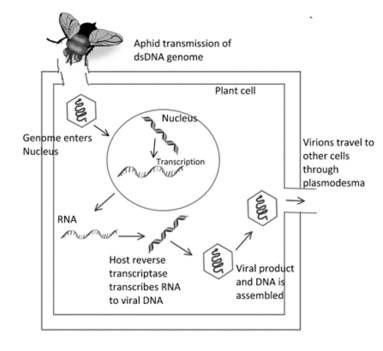| Caulimovirus | |
|---|---|

| |
| TEM micrograph of CaMV virions bar scale equals 100 nm | |
| Virus classification | |
| (unranked): | Virus |
| Realm: | Riboviria |
| Kingdom: | Pararnavirae |
| Phylum: | Artverviricota |
| Class: | Revtraviricetes |
| Order: | Ortervirales |
| Family: | Caulimoviridae |
| Genus: | Caulimovirus |
Caulimovirus is a genus of viruses, in the family Caulimoviridae order Ortervirales. They are para-retroviruses with dsDNA and plants as their host. There are 12 species in this genus. Diseases associated with this genus include: vein-clearing or banding mosaic.
Taxonomy
The genus contains the following species:
- Angelica bushy stunt virus
- Atractylodes mild mottle virus
- Carnation etched ring virus
- Cauliflower mosaic virus
- Dahlia mosaic virus
- Figwort mosaic virus
- Horseradish latent virus
- Lamium leaf distortion virus
- Mirabilis mosaic virus
- Soybean Putnam virus
- Strawberry vein banding virus
- Thistle mottle virus
Structure
Viruses in Caulimovirus are non-enveloped, with icosahedral geometries, and T=7, T=7 symmetry. The diameter is around 50 nm. Genomes are circular and non-segmented. The genome codes for 6 to 7 proteins.
| Genus | Structure | Symmetry | Capsid | Genomic arrangement | Genomic segmentation |
|---|---|---|---|---|---|
| Caulimovirus | Icosahedral | T=7 | Non-enveloped | Circular | Monopartite |
Life cycle

Caulimoviruses achieve entry into plant cells via damaged tissues, transmission via an animal vector (aphid insects) and seeds passed down to generations. Plant cells do not possess receptors like animal cells that would allow the virus to enter and since plant cells are thick, viruses achieve entry as aforementioned. Once inside the plant, the virus spreads using plasmodesmata, a membrane channel found in plants connecting one plant cell to another. Caulimoviruses are para-retroviruses with a DNA genome; thus, part of their viral replication takes place in the nucleus, where the host replication machinery is utilized. The rest of its life cycle takes place in the cytoplasm. Replication follows, where initially the dsDNA enters the nucleus and is transcribed into RNA using the host RNA polymerase. Then, the RNA is reverse transcribed to viral DNA using the host reverse transcriptase in the cytoplasm. The viral product is made and assembled in the cytoplasm, which then spreads to other parts of the plant cell using plasmodesmata. Translation takes place by ribosomal shunting. For most Caulimoviruses, their genome is not integrated into the host cell; however, some viruses, such as Dahlia mosaic virus (genus Caulimovirus), have been identified as having integrated their genome into the host. Transmission routes are mechanical.
| Genus | Host details | Tissue tropism | Entry details | Release details | Replication site | Assembly site | Transmission |
|---|---|---|---|---|---|---|---|
| Caulimovirus | Plants | None | Viral movement; mechanical inoculation | Viral movement | Nucleus | Cytoplasm | Mechanical inoculation: aphids |
Application: Plant Biotechnology
The Caulimovirus mosaic 35S promoter has become a valuable tool for fine-tuning gene expression in plants and altering the phenotypes of transgenic plants. It can be used as modular cassette to control gene activity. Moreover, Caulimoviruses have also been investigated as possible vectors for introducing foreign genes into plants since these viruses have dsDNA. Since Caulimoviruses have regulatory promoter elements, they play a role in developing plant modifications to increase resistance to disease and infections.
References
- ^ "Viral Zone". ExPASy. Retrieved 15 June 2015.
- ^ "Virus Taxonomy: 2020 Release". International Committee on Taxonomy of Viruses (ICTV). March 2021. Retrieved 21 May 2021.
- "Reverse transcriptase | Enzyme Function & Applications | Britannica". www.britannica.com. 13 March 2024. Retrieved 10 April 2024.
- Bak, Aurélie; Emerson, Joanne B. (2020). "Cauliflower mosaic virus (CaMV) Biology, Management, and Relevance to GM Plant Detection for Sustainable Organic Agriculture". Frontiers in Sustainable Food Systems. 4. doi:10.3389/fsufs.2020.00021. ISSN 2571-581X.
- Nasim, Noohi; Dey, Nrisingha (1 March 2022). "Pararetroviruses: Plant Infecting dsDNA Viruses". Plant Molecular Biology Reporter. 40 (1): 106–118. doi:10.1007/s11105-021-01294-7. ISSN 1572-9818.
External links
| Taxon identifiers | |
|---|---|
| Caulimovirus | |